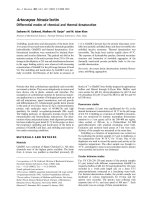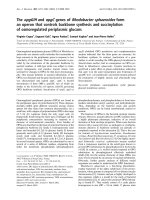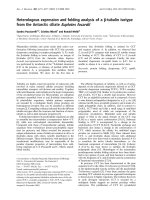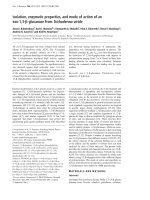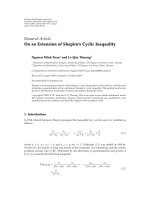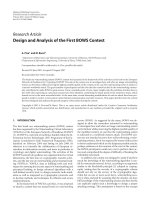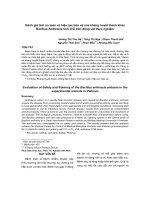Báo cáo y học: "Attitudes towards Chiropractic: An Analysis of Written Comments from a Survey of North American Orthopaedic Surgeons" potx
Bạn đang xem bản rút gọn của tài liệu. Xem và tải ngay bản đầy đủ của tài liệu tại đây (212.72 KB, 28 trang )
This Provisional PDF corresponds to the article as it appeared upon acceptance. Fully formatted
PDF and full text (HTML) versions will be made available soon.
Attitudes towards Chiropractic: An Analysis of Written Comments from a Survey
of North American Orthopaedic Surgeons
Chiropractic & Manual Therapies 2011, 19:25 doi:10.1186/2045-709X-19-25
Jason W Busse ()
Janey Jim ()
Craig Jacobs ()
Trung Ngo ()
Robert Rodine ()
David Torrance ()
Abhaya V Kulkarni ()
Brad Petrisor ()
Brian Drew ()
Mohit Bhandari ()
ISSN 2045-709X
Article type Research
Submission date 19 August 2011
Acceptance date 4 October 2011
Publication date 4 October 2011
Article URL />This peer-reviewed article was published immediately upon acceptance. It can be downloaded,
printed and distributed freely for any purposes (see copyright notice below).
Articles in Chiropractic & Manual Therapies are listed in PubMed and archived at PubMed Central.
For information about publishing your research in Chiropractic & Manual Therapies or any BioMed
Central journal, go to
/>For information about other BioMed Central publications go to
Chiropractic & Manual
Therapies
© 2011 Busse et al. ; licensee BioMed Central Ltd.
This is an open access article distributed under the terms of the Creative Commons Attribution License ( />which permits unrestricted use, distribution, and reproduction in any medium, provided the original work is properly cited.
/>Chiropractic & Manual
Therapies
© 2011 Busse et al. ; licensee BioMed Central Ltd.
This is an open access article distributed under the terms of the Creative Commons Attribution License ( />which permits unrestricted use, distribution, and reproduction in any medium, provided the original work is properly cited.
Attitudes towards Chiropractic:
An Analysis of Written Comments from a Survey of North American
Orthopaedic Surgeons
Jason W. Busse;
1,2
Janey Jim;
3
Craig Jacobs;
3
Trung Ngo;
3
Robert Rodine;
3
David Torrance;
3
Abhaya V. Kulkarni;
4
Brad Petrisor;
5
Brian Drew;
5
Mohit Bhandari
2,5
1
The Institute for Work & Health, 481 University Avenue, Suite 800, Toronto, Ontario M5G
2E9, Canada
2
The Department of Clinical Epidemiology and Biostatistics, McMaster University, 1280 Main
Street West, Hamilton, ON L8S 4K1, Canada
3
The Canadian Memorial Chiropractic College, 6100 Leslie Street
Toronto, ON M2H 3J1, Canada
4
The Division of Population Health Sciences, Hospital for Sick Children, Room 1503, 555
University Ave, Toronto, ON M5G 1X8, Canada
5
The Department of Surgery, McMaster University, 1280 Main Street West, Hamilton, Ontario
L8S 4L8, Canada
2
Email addresses:
Jason W. Busse
Janey Jim
Craig Jacobs
Trung Ngo
Robert Rodine
David Torrance
Abhaya V. Kulkarni
Brad Petrisor
Brian Drew
Mohit Bhandari
Correspondence to: Dr. Jason W. Busse, Institute for Work & Health, 481 University Avenue,
Suite 800, Toronto, Ontario, Canada, M5G 2E9; tel: (416) 927-2027; fax: (416) 927-4167; email:
3
ABSTRACT
Background: There is increasing interest by chiropractors in North America regarding
integration into mainstream healthcare; however, there is limited information about attitudes
towards the profession among conventional healthcare providers, including orthopaedic
surgeons.
Methods: We administered a 43-item cross-sectional survey to 1000 Canadian and American
orthopaedic surgeons that inquired about demographic variables and their attitudes towards
chiropractic. Our survey included an option for respondants to include written comments, and
our present analysis is restricted to these comments. Two reviewers, independantly and in
duplicate, coded all written comments using thematic analysis.
Results: 487 surgeons completed the survey (response rate 49%), and 174 provided written
comments. Our analysis revealed 8 themes and 24 sub-themes represented in surgeons’
comments. Reported themes were: variability amongst chiropractors (n=55); concerns with
chiropractic treatment (n=54); areas where chiropractic is perceived as effective (n=43);
unethical behavior (n=43); patient interaction (n=36); the scientific basis of chiropractic (n=26);
personal experiences with chiropractic (n=21); and chiropractic training (n=18). Common sub-
themes endorsed by surgeon’s were diversity within the chiropractic profession as a barrier to
increased interprofessional collaboration, endorsement for chiropractic treatment of
musculoskeletal complaints, criticism for treatment of non-musculoskeletal complaints, and
concern over whether chiropractic care was evidence-based.
4
Conclusions: Our analysis identified a number of issues that will have to be considered by the
chiropractic profession as part of its efforts to further integrate chiropractic into mainstream
healthcare.
Key Words: orthopaedics; chiropractic; attitude of health personnel; survey
5
BACK GR OUND
In 2006 the Chiropractic Strategic Planning Conference proposed a set of recommendations for
advancing the chiropractic profession in North America [1]. These included interdisciplinary
clinical training, the integration of chiropractic into mainstream healthcare, and increased
interprofessional collaboration. Advancing these initiatives will require endorsement from
healthcare professionals that attend to patient populations who also seek chiropractic care, which
includes physical therapists, family physicians, physiatrists, and orthopaedic surgeons. It is
helpful to establish the attitudes of these professional groups towards chiropractic in order to
understand current levels of interaction and what barriers exist to increased interprofessional
collaboration.
We recently surveyed 1000 North American orthopaedic surgeons (49% response rate) to
inquire about their use of, and attitudes towards, chiropractic [2]. Approximately half of those
surveyed (52%; 252 of 487) referred at least some patients for chiropractic care each year, and
attitudes towards chiropractic ranged from very positive to extremely negative. In our adjusted
generalized linear model, factors associated with more negative attitudes included older age and
endorsement of the research literature, the media or medical school as a source of information
regarding chiropractic. More positive attitudes were associated with endorsing a relationship
with a specific chiropractor as a source of information regarding chiropractic. Our survey
included an option for respondents to provide written comments; however, our initial publication
did not allow for sufficient space to discuss this material in detail due to the amount of data
provided. We therefore reviewed and synthesized this material in order to supplement our
previously reported findings and to further inform current barriers to the integration of
chiropractic into mainstream healthcare.
6
ME T HODS
We have reported details of our questionnaire development and administration elsewhere [2]. In
brief, we developed a 43-item, English language questionnaire to examine orthopaedic surgeons’
attitudes towards chiropractic. Our survey included 20-items that asked respondents to indicate
their attitudes towards chiropractic – the chiropractic attitude questionnaire (CAQ). Each of the
20 questions comprising the CAQ is graded on a 5-point Likert scale, from 0 to 4. The responses
are then summed to arrive at a total score ranging from 0 (most negative attitude towards
chiropractic) to 80 (most positive attitude towards chiropractic). Our survey also included an
option for surgeons to provide written comments regarding additional thoughts they may have
regarding chiropractic.
From July 2006 to June 2007 we administered our survey to a random sample of 500
Canadian orthopaedic surgeons, and from July 2007 to June 2008 we administered the same
survey to a random sample of 500 American orthopaedic surgeons. We administered surveys by
fax, and all surgeons’ offices were telephoned prior to sending a survey to confirm their presence
and fax number. Participants were provided with a disclosure letter detailing the intent of the
survey and explicit instructions that, should they choose not to complete the survey, they could
check a box on the cover page indicating that they did not wish to participate and fax it back to
our attention. At 4 and 8 weeks following the initial mailing, we re-faxed the questionnaire to all
non-responders. We telephoned each office that received a 3
rd
(final) survey prior to faxing in an
effort to encourage completion of the instrument. The McMaster University Research Ethics
Board approved our study.
Statistical analysis
7
We have reported our analysis of respondent’s survey data elsewhere [2] and the current analysis
is restricted to a thematic analysis [3-5] of written comments provided by surgeons. In order to
systematically review comments two reviewers (JWB and JJ) developed a coding system to
categorize themes and sub-themes. We developed coding rules through discussion and after four
major rounds of coding written comments, clusters around themes emerged that we used to build
a coding tree. Each survey that provided written comments could contribute more than 1 theme
or sub-theme, but each theme or sub-theme was only coded once in a single survey to address the
issue of clustering. When the tree structure became stable, as evidenced by new articles
generating no new codes, and disagreement among reviewers became minimal, we applied our
coding strategy, independently and in duplicate, to all written comments. Disagreements were
resolved through discussion to achieve consensus. We decided, a priori, only to present sub-
themes that were endorsed by a minimum of 3 survey respondents. Our selection of quotations
for presentation was guided by consensus among reviewers that selected statements were
particularly informative, representative and succinct.
We generated frequencies for demographic characteristics and calculated mean CAQ
scores for respondents who provided written comments and checked for differences between
Canadian and American surgeons with an independent samples t-test and χ
2
test. We explored for
differences in mean CAQ scores between survey respondents who provided written comments
and those who did not to explore for the presence of an attitudinal bias. All comparisons were 2-
tailed and we set our level of significance at p≤0.01 to account for multiple comparisons. We
performed all analyses using PASW Statistics 18.0 (IBM, New York, NY).
8
R E SUL T S & DISCUSSION
Surgeons completed 487 of 1000 surveys, of which 174 (36% of respondents) provided written
comments. Characteristics of surgeons that provided written comments are provided in Table 1.
We did find evidence of attitudinal bias among surgeons who provided written comments;
specifically, they were more likely to hold less positive attitudes towards chiropractic (mean
difference in CAQ scores = -3.47; 95% confidence interval = -5.68 to -1.27; p=0.002). We coded
a total of 309 sub-themes from all written comments with an overall agreement of 80%. Our
coding revealed 8 distinct themes and 24 sub-themes represented in surgeons’ written comments
(Table 2). A description of these themes and sub-themes, with representative quotes, follows.
Variability amongst chiropractors
The most commonly endorsed theme was diversity within the chiropractic profession: “Wide
range of practice – some are evidence based…others do all sorts of crazy stuff”. Eleven
respondents acknowledged difficulty in answering our survey, in that their responses to a number
of questions would depend on the type of chiropractor under consideration: “Obviously not all
[chiropractors] are the same…This questionnaire relates to the majority of [chiropractors], not
all”. Fourteen respondents dichotomized by ‘good’ and ‘bad’ chiropractors, and 10
acknowledged similar limitations in orthopaedics: “There are good chiropractors and bad
orthopaedic [surgeons] and vice versa”, and: “I explain to my patients that there are excellent
chiropractors just like there are bad orthopaedic surgeons. But I wouldn’t pick one out of a book
or from an ad”. Six respondents felt that diversity among practitioners was harmful to the
chiropractic profession: “I think that chiropractic is hurt by the fringe treatments that some
offer”, and: “… some unethical chiropractors have given the profession a bad name”.
9
Areas where chiropractic treatment is perceived as effective
Three respondents felt that chiropractic care for spinal complaints was effective, and 16 endorsed
care specifically for low back pain: “I feel chiropractic can be beneficial in helping mechanical
low back pain”, and: “I find their usefulness is limited to lumbar mechanical back pain care”.
Sixteen respondents endorsed an expanded role for the treatment of musculoskeletal disorders in
general: “I think chiropractic care is beneficial for musculoskeletal pain if there are no risk
factors”, and: “chiropractors have a role in chronic musculoskeletal pain control”. Eight
surgeons suggested a broad role in the management of non-surgical injuries: “I have a very good
relationship with a [chiropractor]…He has helped many members of our sports teams with
hands on care of acute and chronic non surgical injuries”.
Areas where chiropractic treatment is perceived as unhelpful or problematic
Fifty-four surgeons noted concerns with different aspects of chiropractic care. Some focused on
non-spinal conditions, and 3 with chiropractic management of structural scoliosis; however, most
respondents (n=13) in this category felt that chiropractic care provided short-term benefit only or
was ineffective: “No objective long term benefits”, “Chiropractors understand that a majority of
back or neck strain ailments will resolve with or without ‘therapy’”, and: “It is only after all the
therapy visits that do not require pre-authorization or the insurer notes no improvement that the
worker gets referred for an orthopedic evaluation”.
The second most commonly endorsed concern (n=12) took issue with treatment of non-
musculoskeletal complaints: “I have a huge problem with chiropractors claiming to treat asthma
and ear infections among other non-musculoskeletal problems”, and: “most chiropractors (in my
10
view) are very helpful for spinal complaints. Manipulation for asthma, high blood pressure,
breech presentation is quackery – not evidence based. We all need to stick to what we do best”.
Eleven respondents raised concerns regarding the provision of general medical care by
chiropractors: “Chiropractors are dangerous when they portray themselves as replacements for
patients’ primary care physicians”, and: “There are 2 breeds of chiropractors, one who treats
only musculoskeletal problems and knows their limitations and does not try to treat everything
with manipulation. Then there is the other group who feel they are family physicians which they
are not and try to treat all problems like asthma or infections with manipulation”. Eleven
respondents expressed concerns with adverse events associated with chiropractic care: “In the
last 2 years I have seen 2 patients with vertebral artery dissection within 10 days of chiropractic
neck manipulation”, “Have on several occasions done emergency surgery resulting from
chiropractic management”, and: “In the orthopedic department in which I worked we saw
paraplegics produced by spinal manipulation by chiropractors”.
Patient Interaction
Surgeons were largely critical of chiropractors’ interactions with patients. Most concerns were
directed towards chiropractic terminology, which respondents felt was often misleading or
incorrect: “The concept of ‘adjusting subluxations’ is nonsensical. ‘Adjusting’ hips and
sacroiliac joints is nonsensical”, “Why do chiropractors cling to an antiquated theory as
inappropriate as ‘the humors’?”, “Every patient is told that one leg is longer than the other as
the root of their medical problems”, and: “When chiropractors change the principal that ‘all
disease emanates from the spine and can be cured by manipulation’ they will be more welcome
in the medical community and hospitals. It is no question that they are the best at manipulation”.
11
A number of respondents felt that chiropractors often made false or exaggerated claims:
“False information given to patients - I had a cerebral palsy child going to a chiropractor for 5
years to improve his gait!”, and: “…much of their ‘explanations’ are based on grains of truth
that are distorted to support their claims”; however, 6 did acknowledge non-specific benefits of
the clinical encounter: “Chiropractors are very good at taking care of the ‘worried well’
patients”, and: “Very complimentary (sic) to musculoskeletal care – they often talk to patients for
great lengths of time while treating, unlike ourselves”.
Chiropractic training
Ten surgeons noted concerns with chiropractic training, with two respondents noting a lack of
standardization and 2 mentioning specific schools: “Life chiropractors are scary”, and “I visited
the Canadian Memorial Chiropractic College in Toronto. I was impressed with the similarity of
their basic science curriculum – same books as used in medicine – and the extent of information
covering all symptoms. This does not seem to be the case for all schools in North America”. Two
respondents noted their perception that “younger [chiropractors] are better prepared and
trained than their older colleagues”, while 2 others reported concern regarding “a lack of
diagnostic skills”. Two other surgeons noted their experiences with both well and poorly trained
chiropractors: “I personally use and refer to several extremely well trained [chiropractors] in my
area; however, there are much more poorly trained [chiropractors] than well trained
[chiropractors]. Overall, appropriate treatment by well trained [chiropractors] is very
valuable”.
Eight surgeons noted their perception that the helpful aspects of chiropractic care could
largely be provided by other therapists: “All chiropractic care could be better managed by
12
physiotherapy and occupational therapy”, “Manipulative therapy is not the exclusive domain of
chiropractors. Many physical therapists and athletic therapists are also skilled with that
technique and deserve equal recognition”, and: “Manipulation of back for mechanical back pain
can be done by physiotherapists. There is no need for chiropractors”.
Unethical Behavior
Concerns over excessive treatment by chiropractors were raised by 18 respondents: “Major
problem as I see it, chiropractors tend to place patients on an ‘x amount of treatment’ plan such
as 20 visits. In my opinion they need to perform the service and see if the patient responds and
proceed from there. Not just say ‘you need an x amount of treatment’ plan”, “The concept of
repetitive on-going care (maintenance/prevention) is completely contrary to common sense and
science. This is what I object to”, and: “Many chiropractors take advantage with the lawyers on
auto accident cases. Over treating until the medical payments are exhausted”. Fifteen surgeons
also noted concerns that some chiropractors may be overly financially motivated: “I believe that
most chiropractors are ethical…The trouble is that there are many who team up with unethical
legal/rehab facilities and abuse the system for personal gain, partly at the detriment of patient
care”, and: “Money is the only driving force behind many chiropractor’s treatment plans”.
Five surgeons noted more general concerns with unethical behavior: “Too many
chiropractors engage in unethical practices”, and “When I started practicing 28 years ago
several chiropractors in the area would refer me patients and I’d refer them back. That pattern
ended 15 years ago for unknown reasons except many chiropractors in this area are now
employees of entities that have sales quotas, profit goals, and widening ‘healthcare’ ambitions
that seemingly come first to patient care”. Five respondents advised that the chiropractic
13
profession requires stronger oversight: “Their profession needs more careful government
scrutinizing and control”, “I think that most chiropractors are honest…unfortunately they are
overshadowed by dishonest ones…my opinion is that chiropractors should establish an honest
ethics committee that [medical doctors can report] despicable behavior”, and: “More self
policing by chiropractors at the state level would help them immensely”.
Scientific basis of chiropractic
Twenty respondents took issue with the scientific basis underlying chiropractic: “Most students
now have undergraduate degrees and are relatively well educated in basic sciences in their first
2 years (preclinical). The problem begins when they move into their clinical years where
education becomes ‘indoctrination’. Extracts from basic science are selectively constructed into
a theory of practice with little if any real scientific basis”, “Chiropractic care would be better
accepted in medical circles if it were evidence based/scientific and realistic in its’ claims and
applications to patients”, and: “There is no place for chiropractors to work side by side with
scientific medical practitioners”. Six surgeons advocated for more research into chiropractic
treatment: “We need some evidence based chiropractic. Publications in orthopedic journals or
medical journals with peer review”, and: “[Chiropractors] need to produce more clinical studies
of effectiveness”.
Personal experiences with chiropractic
Thirteen respondents reported positive personal experiences with chiropractic: “Chiropractic has
been a valuable accessory to my practice. In particular dealing with international, national and
professional athletes”, “I have a very good relationship with a [chiropractor]…given a diagnosis
14
is established, his care is very efficacious!”, and: “I go to one myself for neck and back
problems”. However, four surgeons noted negative experiences: “I have personally cared for at
least 2 patients that had wrist tendonitis that were off work for ≥1 year [attending chiropractic
care] that only needed 1 shot to be cured”, and another 4 expressed uncertainty as to the role of
chiropractic in healthcare: “I need more knowledge to utilize chiropractors better!”, and:
“Unclear at this point what their role is”.
Summary of Findings
We found that written comments by orthopaedic surgeons most frequently endorsed diversity
within the chiropractic profession as a barrier to increased interprofessional collaboration.
Surgeons identified that training, diagnostic ability and treatment skills were highly variable
within the chiropractic profession, and highlighted that unethical behaviors by some affected
perceptions of the profession as a whole. Respondents largely felt that chiropractors provided
helpful care for musculoskeletal complaints, and particularly mechanical low back pain, but were
concerned about the potential for adverse events and were very critical of chiropractic
management of non-musculoskeletal conditions. Respondents called for greater integration of
evidence-based practices within chiropractic, more chiropractic-related research, and increased
oversight by regulatory bodies.
Strengths of our study include a detailed assessment of all written comments, conducted
independently and in duplicate and guided by a comprehensive coding strategy; however, our
study does have limitations. Surgeons who provided written comments tended to have more
negative attitudes towards chiropractic. Furthermore, we coded all unique themes or sub-themes
from each survey which means that some respondents contributed more content to our analysis
15
than others. Generalizability of our findings should be explored in a representative sample of
North American orthopaedic surgeons.
Respondents’ general perceptions that chiropractic treatment, primarily defined by joint
manipulation, has been found to be effective for some musculoskeletal complaints (particularly
mechanical low back pain), but not for non-musculoskeletal conditions, is generally consistent
with current evidence [6-14]. Despite some respondent’s concerns, current evidence also
suggests that chiropractic care is not causally related to serious adverse events, specifically
vertebrobasilar artery stroke [15,16]; however, efforts are currently underway to better establish
the risks associated with spinal manipulation [17]. Diversity within the chiropractic profession
has been previously reported [18,19], and some practitioners have concluded that "for every
chiropractor there is an equal and opposite chiropractor" [20].
Unethical practices by some chiropractors have also been acknowledged by the
profession. In 2008 the Ontario Chiropractic Association conducted a membership survey
(n=2775, 34% response rate) which found the majority (67%) “felt that the practices of their
peers are in some way negatively influencing perceptions of the profession” [21]. Opinion
leaders within the chiropractic profession have noted the need for more research and greater
incorporation of evidence-based practices [22-24]; however, internal research capacity is limited.
A 2008 survey of all members of the Canadian Chiropractic Association (~6000 members; 684
responded) found that considerably less than 1% of the profession was engaged in conducting
research [25].
Our findings suggest that there are a number of concerns held by North American
orthopaedic surgeons that should be addressed as part of any efforts to facilitate greater
integration of chiropractic into mainstream healthcare. Our analysis of written comments
16
provided by surgeons emphasized the importance of a number of items that we had incorporated
into our survey. These include chiropractic’s role in managing musculoskeletal and non-
musculoskeletal complaints, perceptions of excessive treatment by chiropractors, and whether or
not chiropractic is perceived as evidence-based. New items suggested by our findings were
diversity within the chiropractic profession as a barrier to interprofessional collaboration,
perceptions of chiropractors as primary care providers, questions regarding where chiropractic
care may be integrated into mainstream healthcare, and general concerns regarding adverse
events associated with chiropractic care.
17
CONC L USI ONS
Our analysis of written comments provided by North American orthopaedic surgeons who
responded to our survey identified a number of issues that will have to be considered by the
chiropractic profession as part of its efforts to further integrate chiropractic into mainstream
healthcare. These include: diversity within the chiropractic profession as a barrier to
interprofessional collaboration, chiropractic’s role in managing musculoskeletal and non-
musculoskeletal complaints, perceptions of excessive treatment by chiropractors, whether or not
chiropractic is evidence-based, whether or not chiropractors are primary care providers, where
chiropractic care may be integrated into mainstream healthcare, and general concerns regarding
adverse events associated with chiropractic care.
18
Competing Interests
The authors declare that they have no competing interests.
19
Authors' contributions
JWB conceived of and coordinated the study, performed the statistical analysis, and drafted the
initial manuscript. CJ, TN, RR and DT administered the surveys and telephoned surgeons’
offices. JWB and JJ coded all data. All authors contributed to survey design, and read and
approved the final manuscript.
20
Acknowledgements
No funds were received for the preparation of this manuscript. Dr. Busse is funded by a New
Investigator Award from the Canadian Institutes of Health Research and Canadian Chiropractic
Research Foundation. Dr. Bhandari is supported, in part, by a Canada Research Chair, McMaster
University.
21
REFERENCES
1. Triano JJ, Goertz C, Weeks J, Murphy DR, Kranz KC, McClelland GC, Kopansky-Giles
D, Morgan W, Nelson CF: Chiropractic in North America: toward a strategic plan
for professional renewal outcomes from the 2006 Chiropractic Strategic Planning
Conference. J Manipulative Physiol Ther 2010; 33(5): 395-405.
2. Busse JW, Jacobs C, Ngo T, Rodine R, Torrance D, Jim J, Kulkarni AV, Petrisor B,
Drew B, Bhandari M: Attitudes Toward Chiropractic: A Survey of North American
Orthopedic Surgeons. Spine (Phila Pa 1976) 2009; 34(25): 2818-2825.
3. Denzin NK, Lincoln YS: Handbook of Qualitative Research. Thousand Oaks, CA: Sage
Publications. 1994.
4. Crabtree BJ, Miller WL: Doing qualitative research. Volume 3. Newbury Park, CA:
Sage. 1992.
5. Marshall C, Rossman GB: Designing qualitative research. Newbury Park, CA: Sage
Publications. 1989.
6. Assendelft WJ, Morton SC, Yu EI, Suttorp MJ, Shekelle PG: Spinal manipulative
therapy for low back pain. Cochrane Database Syst Rev 2004; 1: CD000447.
7. Konijnenberg HS, de Wilde NS, Gerritsen AA, van Tulder MW, de Vet HC:
Conservative treatment for repetitive strain injury. Scand J Work Environ Health
2001; 27(5): 299-310.
22
8. Bronfort G, Haas M, Evans RL, Bouter LM: Efficacy of spinal manipulation and
mobilization for low back pain and neck pain: a systematic review and best evidence
synthesis. Spine J 2004; 4(3): 335-56.
9. Hurwitz EL, Carragee EJ, van der Velde G, Carroll LJ, Nordin M, Guzman J, Peloso PM,
Holm LW, Côté P, Hogg-Johnson S, Cassidy JD, Haldeman S; Bone and Joint Decade
2000-2010 Task Force on Neck Pain and Its Associated Disorders: Treatment of neck
pain: noninvasive interventions: results of the Bone and Joint Decade 2000-2010
Task Force on Neck Pain and Its Associated Disorders. Spine 2008; 33(4 Suppl):
S123-52.
10. Chou R, Huffman LH; American Pain Society; American College of Physicians:
Nonpharmacologic therapies for acute and chronic low back pain: a review of the
evidence for an American Pain Society/American College of Physicians clinical
practice guideline. Ann Intern Med 2007; 147(7): 492-504.
11. Hawk C, Khorsan R, Lisi AJ, Ferrance RJ, Evans MW: Chiropractic care for
nonmusculoskeletal conditions: a systematic review with implications for whole
systems research. J Altern Complement Med 2007; 13(5): 491-512.
12. Ernst E: Chiropractic manipulation for non-spinal pain a systematic review. N Z
Med J 2003; 116(1179): U539.
23
13. Glazener CM, Evans JH, Cheuk DK: Complementary and miscellaneous interventions
for nocturnal enuresis in children. Cochrane Database Syst Rev 2005; 2: CD005230.
14. Hondras MA, Linde K, Jones AP: Manual therapy for asthma. Cochrane Database
Syst Rev 2005; 2: CD001002.
15. Boyle E, Côté P, Grier AR, Cassidy JD: Examining vertebrobasilar artery stroke in
two Canadian provinces. Spine 2008; 33(4 Suppl): S170-5.
16. Cassidy JD, Boyle E, Côté P, He Y, Hogg-Johnson S, Silver FL, Bondy SJ: Risk of
vertebrobasilar stroke and chiropractic care: results of a population-based case-
control and case-crossover study. Spine 2008; 33(4 Suppl): S176-83.
17. Researchers take team approach to patient safety during spinal manipulation. University
of Alberta. ExpressNews. May 19, 2011
/>achtopatientsafetyduringspinalmanipulation.aspx (Accessed on August 19, 2011)
18. Kopansky-Giles D, Papadopoulos C: Canadian chiropractic resources databank
(CCRD): a profile of Canadian chiropractors. J Can Chiropr Assoc 1997; 41(3): 155-
91.

